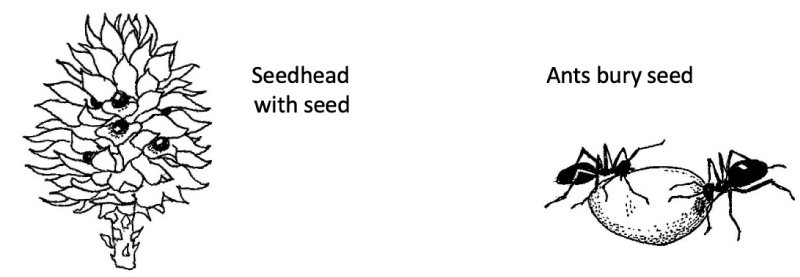

The hard, nut-like seeds of leucospermums and mimeteses are not stored in the canopy of the plant, instead, they drop out of the flower when mature. The seeds are collected by the ants common to the fynbos and store them underground where they eat off the surrounding elaiosome – a soft fleshy skin rich in nutrients, notably lipids and proteins. It is the reward to the ants for all the hard work of dragging them underground to their nests. These nests are usually a short distance from the plant, so seed dispersion is not as wide as hairy Protea seeds that are dispersed by wind. Once underground they are reasonably safe from mice and rats. As the soft skin surrounding the inner nut has a distinctive smell recognized by the ants and mice, there is a competition as to who gets there first. The ants preserve them, the mice eat them. The conditions inside the ants’ nest provide a steady, non-fluctuating soil temperature as an intact plant canopy keeps the sun from penetrating and warming the soil so the seeds enter a state of dormancy. The depth of the stored seed in the ant’s nest varies, but I have buried germinating seeds (at radical emergence) at various depths and at 8 cm the seeds can grow the cotyledons to the surface with a tube type of stem which transforms into a thinner root when the cotyledons emerge above ground.
Leucospermum seeds (technically a fruit classified as an achene) are released a few months after flowering and this presents a few problems in collecting them. The yield can vary greatly, anything between 0 and 18 (Leucospermum conocarpodendron) per flowerhead with the higher number being unusual. If the heads are snapped off well before seed drop, the likelihood is that the seeds will still be immature as they need a week or two between being immature and reaching maturity. Immature seeds are milky white, easily crushed while a week or so later they are turning black under the elaiosome. I have developed a “feel” when to snap off the seed head. A sideways snap and it will come off quite easily while a head with immature seeds will be more resistant. Dissecting with secateurs of the first seed heads on a plant should be done.
The collected heads can then be air-dried in shade for a few days and the seeds pried out with a spike (sharpened nail) or after a longer wait most, but not all will fall out. The viability can be around 50%. To test for viability, I strip off the elaiosomes and drop the seed into water and the floaters can be discarded. Sometimes an entire plant may yield no seeds – this is more likely with an old plant, so I assess the plant and dissect a few seed heads to check this.
Some leucospermums start ejecting their seeds on the sunward side of the flower first while the lee side may be a week or so from maturity and seed drop (e.g. Lsp. Catherinae). Others produce one, maximum two seeds (Lsp. oleifolium) per flowerhead, or none and this can be seen easily if the stamens are gently parted after the flowers have turned brown. The seed matures and darkens in the last few days before it drops. To bag each small flower for maybe one seed is not an option, so the plant needs to be visited every two days or so.